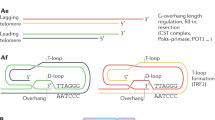Abstract
PURPOSE: The aim of this study was to establish the length of telomeres in familial adenomatous polyposis-associated desmoids. METHODS: DNA from 21 desmoids and five desmoid precursor lesions was digested withHinfI andRsaI restriction enzymes. Southern blotting of the resolved fragments was performed, and the membranes were hybridized with a specific probe attached to a chemiluminescent substrate. Terminal restriction fragment lengths were measured. RESULTS: The median terminal restriction fragment length for the desmoids was 8 (range, 6–9.6)vs. 7.7 (range, 6.4–9.9) kb for their controls. Median terminal restriction fragment length for the desmoid precursor lesions was 9 (range, 7.8–10.4)vs. 8.8 (range, 6.8–10.9) kb for their controls. There was no statistically significant difference between samples and their controls. CONCLUSION: Immortality may not be necessary for desmoid development, or there may be other mechanisms maintaining telomere length. Novel treatments involving telomerase inhibition will be inappropriate in the management of desmoids.
Similar content being viewed by others
References
Zakian VA. Structure and function of telomeres. Ann Rev Genet 1989;23:579–604.
Kim NW, Piatyszek MA, Prowse KR,et al. Specific association of human telomerase activity with immortal cells and cancer. Science 1994;266:2011–5.
Watson J. Origin of concatemeric T7 DNA. Nat New Biol 1972;239:197–201.
Allsopp RC, Vaziri H, Patterson C,et al. Telomere length predicts replicative capacity of human fibroblasts. Proc Natl Acad Sci U S A 1992;89:10114–8.
Hastie ND, Dempster M, Dunlop MG, Thompson AM, Green DK, Allshire RC. Telomere reduction in human colorectal carcinoma and with ageing. Nature 1990;346:866–8.
Harley CB, Futcher AB, Greider CW. Telomeres shorten during aging of human fibroblasts. Nature 1990;345:458–60.
Harley CB. Telomeres and aging. In: Blackburn EH, Greider CW, eds. Telomeres. Cold Spring Harbor: Cold Spring Harbor Press, 1995:247–63.
Harley CB. Telomere loss: mitotic clock or genetic time bomb? Mutat Res 1991;256:271–82.
Bodnar AG, Oullette M, Frolkis M,et al. Extension of life-span by introduction of telomerase into normal human cells. Science 1998;279:349–52.
Wright WE, Piatyszek MA, Rainey WE, Byrd W, Shay JW. Telomerase activity in human germline and embryonic tissues and cells. Dev Genet 1996;18:173–9.
Shay JW, Bacehetti S. A survey of telomerase activity in human cancer. Eur J Cancer 1997;33:787–91.
Bryan TM, Englezou A, Dalla-Pozza L, Dunham MA, Reddel RR. Evidence for an alternative mechanism for maintaining telomere length in human tumors and tumor-derived cell-lines. Nat Med 1997;3:1271–4.
Allshire RC, Dempster M, Hastie ND. Human telomeres contain at least three types of G-rich repeats distributed non-randomly. Nuc Acids Res 1989;17:4611–27.
Gurbuz AK, Giardiello FM, Petersen GM,et al. Desmoid tumours in familial adenomatous polyposis. Gut 1994;35:377–81.
Church JM. Desmoid tumours in familial adenomatous polyposis. Surg Oncol Clin North Am 1994;3:435–47.
Nugent KP, Spigelman AD, Phillips RK. Life expectancy after colectomy and ileorectal anastomosis for familial adenomatous polyposis. Dis Colon Rectum 1993;36:1059–62.
Belchetz LA, Berk T, Bapat BV, Cohen Z, Gallinger S. Changing causes of mortality in patients with familial adenomatous polyposis. Dis Colon Rectum 1996;39:384–7.
Clark SK, Johnson Smith TG, Katz DE, Reznek RH, Phillips RK. Identification and progression of a desmoid precursor lesion in patients with familial adenomatous polyposis. Br J Surg 1998;85:970–3.
Scates DK, Clark SK, Phillips RK, Venitt S. Lack of telomerase in desmoids occurring sporadically and in association with familial adenomatous polyposis. Br J Surgery 1998;85:965–9.
Stout AP. The fibromatoses and fibrosarcoma. Bull Hosp Joint Dis 1951;12:126–30.
Lotfi AM, Dozois RR, Gordon H,et al. Mesenteric fibromatosis complicating familial adenomatous polyposis: predisposing factors and results of treatment. Int J Colorectal Dis 1989;4:30–6.
Rodriguez-Bigas MA, Mahoney MC, Karakousis CP, Petrelli NJ. Desmoid tumors in patients with familial adenomatous polyposis. Cancer 1994;74:1270–4.
Soule EH, Scanlon PW. Fibrosarcoma arising in an extra-abdominal desmoid; report of a case. Mayo Clin Proc 1962;37:443–51.
Church JM. Desmoid tumours in patients with familial adenomatous polyposis. Semin Colon Rectal Surg 1995;6:29–32.
Alman BA, Pajerski ME, Diaz-Cano S, Corboy K, Wolfe HJ. Aggressive fibromatosis (desmoid tumour) is a monoclonal disorder. Diagn Mol Pathol 1997;6:98–101.
Palmirotta R, Curia MC, Esposito DL,et al. Novel mutations and inactivation of both alleles of the APC gene in desmoid tumors. Hum Mol Genet 1995;4:1979–81.
Miyaki M, Konishi M, Kikuchi-Yanoshita R,et al. Coexistence of somatic and germ-line mutations of APC gene in desmoid tumors from patients with familial adenomatous polyposis. Cancer Res 1993;53:5079–82.
Harley CB, Kim NW, Prowse KR,et al. Telomerase, cell immortality, and cancer. Cold Spring Harbor Symp Quant Biol 1994;59:307–15.
Vogelstein B, Kinzler K. The multistep nature of cancer. Trends Genet 1993;9:138–41.
Vaziri H, Dragowska W, Allsopp RC, Thomas TE, Harley CB, Lansdorp PM. Evidence for a mitotic clock in human hematopoietic stem cells: loss of telomeric DNA with age. Proc Natl Acad Sci U S A 1994;91:9857–60.
Smits R, van der Houven van Oordt W, Luz A,et al. Apc1638N: a mouse model for familial adenomatous polyposis-associated desmoid tumors and cutaneous cysts. Gastroenterology 1998;114:275–83.
Chadeneau C, Hay K, Hirte HW, Gallinger S, Bacchetti S. Telomerase activity associated with acquisition of malignancy in human colorectal cancer. Cancer Res 1995;55:2533–6.
Counter CM, Gupta J, Harley CB, Leber B, Bachetti S. Telomerase activity in normal leukocytes and in hematological malignancies. Blood 1995;85:2315–20.
Author information
Authors and Affiliations
About this article
Cite this article
Middleton, S.B., Pack, K. & Phillips, R.K.S. Telomere length in familial adenomatous polyposis-associated desmoids. Dis Colon Rectum 43, 1535–1539 (2000). https://doi.org/10.1007/BF02236734
Issue Date:
DOI: https://doi.org/10.1007/BF02236734




